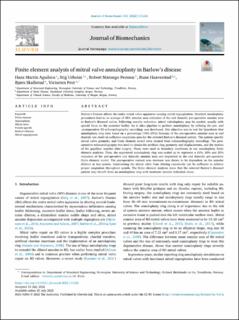| dc.contributor.author | Aguilera, Hans Martin | |
| dc.contributor.author | Urheim, Stig | |
| dc.contributor.author | Persson, Robert | |
| dc.contributor.author | Haaverstad, Rune | |
| dc.contributor.author | Skallerud, Bjørn Helge | |
| dc.contributor.author | Prot, Victorien Emile | |
| dc.date.accessioned | 2022-11-15T10:44:43Z | |
| dc.date.available | 2022-11-15T10:44:43Z | |
| dc.date.created | 2022-08-15T12:52:15Z | |
| dc.date.issued | 2022 | |
| dc.identifier.citation | Journal of Biomechanics. 2022, 142, . | en_US |
| dc.identifier.issn | 0021-9290 | |
| dc.identifier.uri | https://hdl.handle.net/11250/3031876 | |
| dc.description.abstract | Barlow’s Disease affects the entire mitral valve apparatus causing mitral regurgitation. Standard annuloplasty procedures lead to an average of 55% annular area reduction of the end diastolic pre-operative annular area in Barlow’s diseased valves. Following annular reduction, mitral valvuloplasty may be needed, usually with special focus on the posterior leaflet. An in silico pipeline to perform annuloplasty by utilizing the pre- and -postoperative 3D echocardiographic recordings was developed. Our objective was to test the hypothesis that annuloplasty ring sizes based on a percentage (10%–25%) decrease of the pre-operative annular area at end diastole can result in sufficient coaptation area for the selected Barlow’s diseased patient. The patient specific mitral valve geometry and finite element model were created from echocardiography recordings. The post-operative echocardiography was used to obtain the artificial ring geometry and displacements, and the motion of the papillary muscles after surgery. These were used as boundary conditions in our annuloplasty finite element analyses. Then, the segmented annuloplasty ring was scaled up to represent a 10%, 20% and 25% reduction of the pre-operative end diastolic annular area and implanted to the end diastolic pre-operative finite element model. The pre-operative contact area decrease was shown to be dependent on the annular dilation at late systole. Constraining the mitral valve from dilating excessively can be sufficient to achieve proper coaptation throughout systole. The finite element analyses show that the selected Barlow’s diseased patient may benefit from an annuloplasty ring with moderate annular reduction alone. | en_US |
| dc.description.abstract | Finite element analysis of mitral valve annuloplasty in Barlow's disease | en_US |
| dc.language.iso | eng | en_US |
| dc.publisher | Elsevier Science | en_US |
| dc.rights | Navngivelse 4.0 Internasjonal | * |
| dc.rights.uri | http://creativecommons.org/licenses/by/4.0/deed.no | * |
| dc.title | Finite element analysis of mitral valve annuloplasty in Barlow's disease | en_US |
| dc.title.alternative | Finite element analysis of mitral valve annuloplasty in Barlow's disease | en_US |
| dc.type | Peer reviewed | en_US |
| dc.type | Journal article | en_US |
| dc.description.version | publishedVersion | en_US |
| dc.source.pagenumber | 8 | en_US |
| dc.source.volume | 142 | en_US |
| dc.source.journal | Journal of Biomechanics | en_US |
| dc.identifier.doi | 10.1016/j.jbiomech.2022.111226 | |
| dc.identifier.cristin | 2043026 | |
| cristin.ispublished | true | |
| cristin.fulltext | original | |
| cristin.qualitycode | 2 | |

